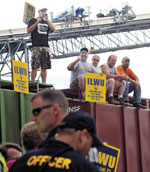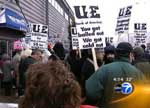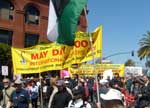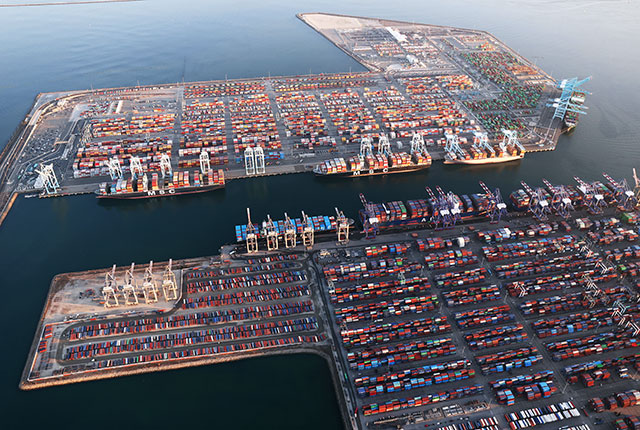Labor's Gotta Play
Hardball to Win!

Showdown on West Coast Docks: The Battle of Longview
(November 2011).
click on photo for article

Chicago Plant Occupation Electrifies Labor
(December 2008).
click on photo for article

May Day Strike Against the War Shuts Down
U.S. West Coast Ports
(May 2008)
click on photo for article

April 2023
Local
13 and 10 Show the Way Forward for ILWU!
ILWU: No Contract, No Work!
ILA
Ranks: Don’t Work Diverted Cargo! Solidarity with
ILWU!

The twin ports of Los Angeles (above) and Long Beach are the largest in the U.S. and together account for 40% of all the cargo coming into the country. For a unified nationwide ILWU-ILA port strike! (Mario Tama / Getty Images)
By members of the International Longshore and Warehouse Union
The International Longshore and Warehouse Union (ILWU) has been working without a contract for ten months, reportedly locked in intractable bargaining with the employers for almost a year. In an attempt to allay workers’ concerns, on April 20, the union issued a press release saying that negotiators have reached a “tentative agreement” on “certain key issues.” A few hours later the employers’ Pacific Maritime Association (PMA) issued its own press release, saying that while there had been significant progress, “several key issues remain unresolved.” Which issues? On February 23, a joint press release said that negotiators were hopeful about reaching an agreement “soon.” Not so soon, turns out. And last July 26 the union announced agreement on continuing benefits. But as to what’s being negotiated, one point of agreement is to keep the union membership in the dark.
This is the longest continuous time that ILWU has been working without a contract or strike. The Longshore Caucus used to authorize the Bargaining Committee with power to declare a strike to let PMA know we mean business. When our union was strong, no contract meant no work. It should be that way today.
Earlier this month, frustrated by the negotiations stalemate, Local 13 longshore workers in the two busiest U.S. ports, Los Angeles and Long Beach (L.A./LB), shut down the docks over safety issues on April 6 and 7 as they “red-tagged” faulty equipment in one of the most dangerous industries. Automated terminals, in particular, were hit. PMA put out a statement complaining that the action was “not routine”. But there is no “routine” because there is no signed agreement between the employers and the union. Last November there were safety issues in Oakland where the members took action and shut down terminals.
These rank-and-file job actions reflect the anger of longshore workers up and down the Coast toward the PMA, which is clearly using stalling tactics in negotiations essentially over the key question of automation, which threatens to eliminate thousands of longshore jobs. Not only is the membership not being informed, last June, four days after meeting with President Joe Biden on the USS Iowa in San Pedro, the ILWU tops issued a joint statement with the PMA agreeing not to strike. Yet the right to strike is the only leverage the union has in negotiations.
There should be an elected strike committee. Longshore workers need to take action to gain control of safety, technology and automation. The largest local on the Coast has thrown down the gauntlet. It’s time for the other locals to pick it up with coastwise strike action.
The bosses are gearing up. Back in March, a coalition of 238 shippers called on President Biden to intervene. Remember that Biden (who calls himself “the most pro-union president” ever) and Congress intervened in railroad labor talks last year. They pushed through a law making an impending rail strike illegal, and imposed a contract with no sick leave that a majority of union members had voted down.
Let’s not forget, also, that in 2012 the Democratic Obama-Biden administration ordered an armed Coast Guard cutter to escort a scab ship to the EGT terminal in Longview, Washington, in a blatant effort to back the grain monopolies against the ILWU. And in 2002, Republican president George W. Bush, at the urging of Democratic Senator Diane Feinstein, invoked the slave-labor Taft-Hartley Act to get war materiel moving for the impending U.S. invasion of Iraq. Longshore workers must be prepared to take on strikebreaking by Democrats and Republicans.
It’s high time to strike! The ILA in the Gulf and East Coast ports must support our strike. Don’t work diverted cargo! A victory for ILWU is a victory for ILA and all labor!
Diverted Cargo is Scab Cargo –
ILA Must Refuse to Handle Scab Cargo
Over the last couple years, South Atlantic and Gulf Coast ports represented by the International Longshoremen’s Association (ILA) have increased their share of the Asian trade. At the height of the pandemic this was mainly due to supply chain issues, but last year shippers said they were afraid of labor disruptions in the absence of an ILWU-PMA contract. Partly, this is a scare tactic to get the ILWU to “moderate” its demands. But if there is a West Coast dock strike, or even more “labor disruptions,” even though the cost is almost double, you can bet shippers will divert cargo through the Panama Canal. And in that case, the ILA must refuse to touch it: scab cargo, too hot to handle!
It’s a principle for transport unions not to work diverted cargo, whether it’s a strike or job actions during contract negotiations. At the ILA’s 2019 convention, International president Harold Daggett said that during the union’s 1977 strike he was one of a group of ILA longshoremen invited to the West Coast by ILWU President Jimmy Herman to picket ships diverted there by shipowners to avoid the ILA strike. Daggett said ILWU longshoremen honored their picket lines in Long Beach and San Francisco. He then announced a “Solidarity Pact.” With ILWU President Willie Adams at the podium he exclaimed, “ILWU saved our union!” The time has come for the ILA to reciprocate.
In 2000, the ILWU took job action to defend ILA Local 1422 in the port of Charleston, South Carolina, when they were under attack by Nordana Lines and the state. ILA President John Bowers refused to defend his own union local. Yet the ILWU shut down West Coast ports demanding hands off the Charleston 5, raised money, appealed to the Spanish dockers for solidarity action and they refused to handle scab cargo. There was a march of thousands led by ILWU Local 10’s Drill Team to the South Carolina state capitol, which still had the flag of the Confederacy flying over it. Helicopters overhead and armed state troopers on roofs of buildings protected the symbol of slavery and tried to intimidate thousands of union marchers. The Charleston 5 campaign ended in a victory for the entire labor movement, but Daggett was AWOL during this heroic struggle.
Who benefits from an attempt to thwart union power by diverting cargo? Clearly, it would be the East Coast employers and their partners in maritime labor who seek to ingratiate themselves with the bosses. No wonder Harold Daggett received the “Man of the Year” award from the maritime shipping companies. For that matter, Adams’ predecessor at the helm of the ILWU, “Big Bob” McEllrath, got a joint award together with the head of the PMA from Harvard Business School in recognition of their contributions to class collaboration.
Last year, for the first time in history the ILA held a convention on the West Coast in San Diego, California, two weeks after the ILWU contract expired on July 1. Several weeks earlier Daggett put out a video directed to ILWU members, saying he knows how to hang tough and deal with automation. What’s going on here? Is Daggett preparing a raid, an attempted takeover of ILWU? What’s needed now is not a labor faker’s bluster, but for ILA to show some real longshore solidarity in action!
Business Unionism vs. Class Struggle Unionism
Historically, the two longshore unions have been on the opposite ends of the political spectrum. (Read Reds or Rackets? The Making of Radical and Conservative Unions on the Waterfront, by Howard Kimeldorf.) The ILWU had a reputation of being a democratic, bottom-up union with an internationalist perspective that has taken job actions on contractual, anti-war and social justice issues. The ILWU offered safe haven to maritime workers who were purged during the anti-communist McCarthy witch-hunt hysteria.
On the other hand, the ILA, a top-down, business union is partners with USMX employers, holding a super-patriotic view that has supported every U.S. imperialist war. It hasn’t had a coastwide strike in nearly a half a century. It still has segregated locals with majority black longshore locals politically dominated in the union regionally by white checker bureaucrats. Its master contract does not provide for the same wages, working conditions and pension benefits for all ports, but the officers take care of themselves with multiple salaries. They say ILA means “I Love America” and it bans “subversives” (i.e., militants) from membership.
Yet the juxtaposition of the two unions seems to be shifting as ILWU tops move to the right. The ILWU’s keystone, its Ten Guiding Principles, encapsulating the fundamentals of solid trade unionism, was hammered out during the McCarthy period when CIO unions like the Marine, Cooks and Stewards Union (MCS) were being busted by employers and raided by the AFL. Militants were fired, deported and imprisoned, like MCS President Hugh Bryson. Yet in the last 20 years ILWU officials have been abandoning those Ten Guiding Principles, for example by directing longshore workers to cross picket lines of port truckers trying to organize a union.
During the combative struggle in 2011-12 against a non-union grain terminal being built in Longview, Washington, longshore workers occupied the EGT facility on the dock and blocked railroad tracks to stop trains from passing through to the scab operation. When employers got an injunction against the union, the scene was like something out of the classic union film Salt of the Earth. Local 21 Secretary-Treasurer Byron Jacobs was maced by police in the eyes, then handcuffed, as wives, sisters and aunts took the place of strikers sitting down on the rail tracks. When the first scab ship was being escorted downriver by an armed Coast Guard cutter to the EGT terminal, police forces from Washington and Oregon were mobilized. ILWU President Bob McEllrath, afraid of a confrontation between police and ILWU pickets reinforced by Occupy activists, capitulated. He violated ILWU’s Constitution, and ordered the local officers to sign the proposed EGT agreement without a vote by the members of Local 21, violating the ILWU Constitution which ensures the members right to vote on contracts.
Another qualitative change occurred last year: the ILWU Coast Committee headed by President Adams voted to boycott Russian ships, which rarely call in U.S. ports. They cited the war in Ukraine, which was in fact provoked by NATO’s expansion to the Russian border. Rank-and-file ILWU militants opposed the proxy war. In the past, the ILWU opposed every U.S./NATO war since WWII: Korea, Vietnam, Yugoslavia. On May Day 2008, the ILWU shut down every port on the West Coast demanding an end to the U.S. war on Afghanistan and Iraq! Meanwhile, the ILA has supported every bloody U.S. war. In a display of false bravado, the ILA’s Daggett boasts that he cajoled President Biden into calling for a phantom boycott of Russian ships.
Automation of the Ports - the Big Fight
In Rotterdam there are marine terminals which are totally automated with only a handful of dockworkers moving cargo that once required hundreds. This is what PMA is doing at Tra-Pac in L.A. and why longshore workers are resisting. That is what stevedoring companies and terminal operators are attempting to do in container ports around the world. Daggett never mentions that the ILA has a serious problem with non-union terminals in the Gulf and Atlantic ports. Actually, the ILA has semi-automated terminals in Daggett’s front yard, Bayonne, N.J., and in Newport News, Virginia. Some ports have 12-hour shifts. The ILA has done a better job of slowing down automation than ILWU, but they’re in a weaker position when it comes to taking job action to fight automation.
In 2019, at the ILA Convention President Daggett proclaimed that if the two longshore unions got together it would be the strongest maritime union in the world. Yes, the two longshore unions together could be a powerful force in the labor movement in the world’s largest capitalist economy. Seaports are choke points in the global supply chain. In fact, there should be one longshore union but with a leadership committed to fighting the employers not Daggett’s shameful "kiss ass partnership” with ILA's maritime bosses.
Automation is the real sticking point in the contract negotiations, everyone knows it and the ILWU tops have no program to fight it. In the end they will go along to get along.
Already hundreds of jobs have been lost at the fully automated container terminal in Long Beach. How can this be fought? The strength of a union resides in its active and informed membership mobilized on a program of hard class struggle. Automation is not going to go away. Rather, workers need to fight like hell to make it work for them. The ILWU should be fighting for union control of technology. Against threatened job losses, there should be a fight to reduce hours with no loss in pay – 30 hours work for 40 hours pay. That provides a fourth shift of six hours.
Local 10 raised the proposal of “30 for 40” for contract negotiations at the Longshore Caucus years ago but some steady men from L.A./LB Local 13 opposed it because they argued it would interfere with their ability to work multiple shifts in one day. How short-sighted can you get? Fighting job losses due to automation by demanding of the employers four shifts of six hours each at no loss in pay won’t come easy – it would require mobilization of the rank and file for strike action.
To strike to win, means building the picket line and fighting politically. That means breaking with all parties of the bosses and building a class-struggle workers party. It means building support by championing the cause of all the oppressed, as the ILWU did when it shut down the West Coast on Juneteenth 2020 protesting police terror and systemic racism. Black ILA longshore leaders in the South wanted to join the ILWU protest and shutdown the whole country, a historic first, but all work stoppages have to be approved by Daggett, the president, and that was the kiss of death.
Bottom line: longshore workers need a class-struggle union with a leadership with the program and determination to take on the employers, their politicians and the whole arsenal they will throw at us with a unified nationwide strike.
Jack Heyman Local 10 (#8780 retired)
Anthony Leviege Local 34 (#9576)
David “Newt” Newton Local 10 (#101386)